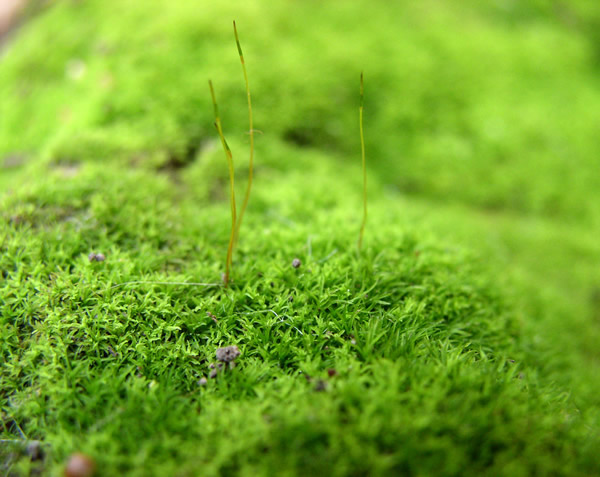 |
| Mosses |
Members of the ten thousand species of the class Bryopsida or Musci in the order Bryophyta, mosses are usually tiny, fragile, nonflowering, spore-bearing plants. They are related to hornworts and liverworts.
Mosses evolved from green algae before the existence of reptiles and flying insects. Fossils from the Devonian period, about 410million to 353 million years ago, contain mosses. The first known mosses lived 286 million to 245 million years ago, during the Permian period.
By the Tertiary period, approximately 66.4 million to 1.6 million years ago, at least one hundred moss species existed. Fossilized mosses, including Muscites, Palaeohypnum, and Protosphagnum, resemble modern moss species structurally, indicating that mosses have not evolved quickly.
  |
Found globally, mosses prefer damp, shady, sparsely vegetated environments and often grow on land adjacent to bodies of fresh water and in woods, sometimes appearing carpet like.
Some mosses prefer rotting wood, while others thrive in soil saturated with water or bare soil. Although hardy, mosses are sensitive to pollutants. Mosses need external sources of moisture to transport nutrients.
They can adapt to environments, exhibiting variations. Although many mosses live in temperate zones, they also have been found living in tundra. Mosses can grow on rocks, mountains, and brick and cement structures. They are frequently found on tombstones and other memorials.
Mosses are categorized into three groups, the true mosses (Bryopsida or Musci), the peat mosses (Sphagnopsida), and the granite mosses (Andreaopsida). The greatest number of moss species are in the subclass Bryidae. Some subclasses contain only a few species.
Most mosses are short. Cape pygmy moss (Ephemerum capensi), the size of a pencil dot, is the tiniestmoss that can be seen without a microscope. The largest mosses are 1 meter (40 inches) long. Water mosses in the order Bryales live in streams and ponds, sometimes adhering to tree roots or rocks.
Brookmoss grows shoots ranging from30 to 100 centimeters (12 to 40 inches) long. Common mosses include hair-cap, sheet, top, slit, granite, broom, and wind-blown mosses. Luminous mosses, whose curved cells concentrate light on chloroplasts for photosynthesis, grow in dark spaces.
Mosses consist of green stems and leaves that are usually one cell thick and sometimes havemidribs. Leaf cell shape and pattern are used to identify mosses, and differences can be detected microscopically.
Instead of roots, each moss stem has rhizoids which secure the plant to the ground. Lacking a vascular system to conduct fluid, mosses need a watery environment to distribute male gametes.
Life Cycle
 |
| Mosses life cycle |
Mosses have two reproductive forms, referred to as the alternation of generations. During the gametophytic, or sexual, generation, a gametophyte creates a plant body known as the thallus. Two specialized organs are involved in sexual reproduction.
The antheridium is a sac that produces male gametes, eachwith two flagella, and the archegonium is the bottle-shaped female sexual organ. Short cell filaments, called the paraphyses, are associated with the antheridium. Usually both sexual organs are located on moss leaves.
Sperm fertilizes the egg to create a maroon colored stalk called a seta,which has a sporangium, or spore capsule, in the sporophytic generation. The sporangium consists of an urn, peristome, annulus, operculum, and calyptra. Capsule components vary by species.
This sporangium relies on the gametophyte to deliver necessary nourishment and moisture. When the sporophyte dries, spores are scattered like dust and germinate to become threadlike protonema, an immature moss form, which form new gametophytes.
During wet conditions, the capsule can with hold spores by closing from one to two rows of peristome teeth. Because spores are sensitive to moisture, temperature, and soil chemistry and have limited supplies of energy for protonema to grow, odds are that only one spore per million forms a mature moss plant. Mosses also reproduce asexually by growing from fragments of stems and leaves that germinate into new plants.
Uses
Ecologically, mosses serve several purposes. They help secure soil by forming patches of dense mats of ground cover and absorb water to prevent erosion. Mosses also provide nutrients that enrich soils for future plant growth. Mosses are popular terrarium plants. They are often illegally harvested from public lands, including national forests.
 |
| forming patches of dense mats of ground cover |
The word “moss” in plant names does not always indicate a moss species. The club moss is, in fact, an evergreen herb from the family Lycopodiaceae, and its relatives, the spike mosses, are primitive vascular plants in the family Selaginellaceae.
Often, people in the Northern Hemisphere use moss to tell direction because it grows on the north-facing sides of trees and structures, where sunlight does not shine directly.
Green algae that grow on trees’ northern sides are referred to as moss but usually are not. Other types of algae, such as pond moss, are incorrectly described as mosses. Spanish moss is one of the best-known plants called a moss, but it actually is a lichen and air plant belonging to the pineapple family, Bromeliaceae.
   |
Some moss species in the genus Sphagnum, of the order Sphagnales, partially decompose into carbonized tissues in acidic, watery areas such as bogs to become peat,which is significant economically as a fuel and as a commercial gardening product.
Empty moss cell spaces absorb water, and bogs become drier. Peat mosses float in mats, prevent fungi and bacteria from multiplying, and create an environment that can preserve carcasses. Prior to the development of modern medical techniques, sphagnummoss was used to dress surgical sites because of its antiseptic qualities.